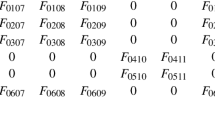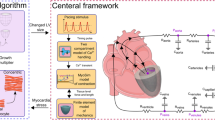Abstract
In contrast to the widely applied approach to model soft tissue remodeling employing the concept of volumetric growth, microstructurally motivated models are capable of capturing many of the underlying mechanisms of growth and remodeling; i.e., the production, removal, and remodeling of individual constituents at different rates and to different extents. A 3-dimensional constrained mixture computational framework has been developed for vascular growth and remodeling, considering new, microstructurally motivated kinematics and constitutive equations and new stress and muscle activation mediated evolution equations. Our computational results for alterations in flow and pressure, using reasonable physiological values for rates of constituent growth and turnover, concur with findings in the literature. For example, for flow-induced remodeling, our simulations predict that, although the wall shear stress is restored completely, the circumferential stress is not restored employing realistic physiological rate parameters. Also, our simulations predict different levels of thickening on inner versus outer wall locations, as shown in numerous reports of pressure-induced remodeling. Whereas the simulations are meant to be illustrative, they serve to highlight the experimental data currently lacking to fully quantify mechanically mediated adaptations in the vasculature.
Similar content being viewed by others
References
Baer E, Cassidy JJ, Hiltner A (1992) Hierarchial structure of collagen composite systems—lessons from biology. ACS Symp Ser 489: 2–23
Barocas VH, Tranquillo RT (1997a) A finite element solution for the anisotropic biphasic theory of tissue-equivalent mechanics: the effect of contact guidance on isometric cell traction measurement. J Biomech Eng 119(3): 261–268
Barocas VH, Tranquillo RT (1997b) An anisotropic biphasic theory of tissue-equivalent mechanics: the interplay among cell traction, fibrillar network deformation, fibril alignment, and cell contact guidance. J Biomech Eng 119(2): 137–145
Brankov G, Rachev AI, Stoychev S (1975) A composite model of large blood vessels. In: Brankov G (eds) Mechanics of biological solid: Proceedings of the Euromech colloquium. Publishing House of the Bulgarian Academy of Sciences, Varna, pp 71–78
Chuong CJ, Fung YC (1986) On residual stresses in arteries. J Biomech Eng 108(2): 189–192
Driessen NJB, Boerboom RA, Huyghe JM, Bouten CVC, Baaijens FPT (2003a) Computational analyses of mechanically induced collagen fiber remodeling in the aortic heart valve. J Biomech Eng 125: 549–557
Driessen NJB, Peters GWM, Huyghe JM, Bouten CVC, Baaijens FPT (2003b) Remodelling of continuously distributed collagen fibres in soft connective tissues. J Biomech 36: 1151–1158
Driessen NJB, Wilson W, Bouten CVC, Baaijens FPT (2004) A computational model for collagen fibre remodelling in the arterial wall. J Theor Biol 226(1): 53–64
Driessen NJB, Bouten CVC, Baaijens FPT (2005) A structural constitutive model for collagenous cardiovascular tissues incorporating the angular fiber distribution. J Biomech Eng 127(3): 494–503
Fridez P, Rachev A, Meister J-J, Hayashi K, Stergiopulos N (2001) Model of geometrical and smooth muscle tone adaptation of carotid artery subject to step change in pressure. Am J Physiol Heart Circ Physiol 280: H2752–H2760
Gleason RL, Humphrey JD (2004) A mixture model of arterial growth and remodeling in hypertension: altered muscle tone and tissue turnover. J Vasc Res 41(4): 352–363
Gleason RL, Humphrey JD (2005a) Effects of a sustained extension on arterial growth and remodeling: a theoretical study. J Biomech 38(6): 1255–1261
Gleason RL, Humphrey JD (2005b) A 2-D constrained mixture model for arterial adaptations to large changes in flow, pressure, and axial stretch. Math Med Biol 22(4): 347–369
Gleason RL, Wan W (2008) Theory and experiments for mechanically-induced remodeling of tissue engineered blood vessels. Adv Sci Technol 57: 226–234
Gleason RL, Taber LA, Humphrey JD (2004a) A 2-D model of flow-induced alterations in the geometry, structure, and properties of carotid arteries. J Biomech Eng 126: 371–381
Gleason RL, Hu J-J, Humphrey JD (2004b) Building a functional artery: issue from the perspective of mechanics. Front Biosci 9: 2045–2055
Gleason RL, Wilson E, Humphrey JD (2007) Biaxial biomechanical adaptations of mouse carotid arteries cultured at altered axial extension. J Biomech 40(4): 766–776
Hansen L, Wan W, Gleason RL (2009) Microstructurally-motivated constitutive modeling of mouse arteries cultured under altered axial stretch. J Biomech Eng 131(10): 101015 (11 p)
Humphrey JD (2002) Cardiovascular solid mechanics: cells, tissues, organs. Springer, New York
Humphrey JD, Rajagopal KR (2002) A constrained mixture model for growth and remodeling of soft tissues. Math Models Meth Appl Sci 12(3): 407–430
Humphrey JD, Rajagopal KR (2003) A constrained mixture model for arterial adaptations to a sustained step change in blood flow. Biomech Model Mechanobiol 2: 109–126
Kamiya A, Togawa T (1980) Adaptive regulation of wall shear stress to flow change in the canine carotid artery. Am J Physiol 239(1): H14–H21
Kuhl E, Garikipati K, Arruda EM, Grosh K (2005) Remodeling of biological tissue: mechanically induced reorientation of a transversely isotropic chain network. J Mech Phys Solids 53(7): 1552–1573
Lanir Y (1983) Constitutive equations for fibrous connective tissues. J Biomech 16: 1–12
Martinez-Lemus LA, Hill MA, Bolz SS, Pohl U, Meininger GA (2004) Acute mechanoadaptation of vascular smooth muscle cells in response to continuous arteriolar vasoconstriction: implications for functional remodeling. FASEB J 18(6): 708–710
Matsumoto T, Hayashi K (1996) Stress and strain distribution in hypertensive and normotensive rat aorta considering residual stress. J Biomech Eng 118: 62–73
Mow VC, Kuei SC, Lai WM, Armstrong CG (1980) Biphasic creep and stress relaxation of articular cartilage in compression? Theory and experiments. J Biomech Eng 102(1): 73–84
Rachev A (1997) Theoretical study of the effect of stress-dependent remodeling on arterial geometry under hypertensive conditions. J Biomech 30(8): 819–827
Rachev A (2000) A model of arterial adaptation to alterations in blood flow. J Elast 61: 83–111
Rachev A, Hayashi K (1999) Theoretical study of the effects of vascular smooth muscle contraction on strain and stress distributions in arteries. Ann Biomed Eng 27: 459–468
Raykin J, Rachev AI, Gleason RL (2009) A phenomenological model for mechanically mediated growth, remodeling, damage, and plasticity of gel-derived tissue engineered blood vessels. J Biomech Eng 131(10): 101016 (12 p)
Rodriguez EK, Hoger A, McCulloch AD (1994) Stress-dependent finite growth in soft elastic tissues. J Biomech 27: 455–467
Skalak R (1981) Growth as a finite displacement field. Martinus Nijhoff, The Hague
Skalak R, Zargaryan S, Jain RK, Netti PA, Hoger A (1996) Compatibility and the genesis of residual stress by volumetric growth. J Math Biol 34(8): 889–914
Taber LA (1998) A model of aortic growth based on fluid shear and fiber stresses. J Biomech Eng 120: 348–354
Taber LA, Eggers DW (1996) Theoretical study of stress-modulated growth in the aorta. J Theor Biol 180(4): 343–357
Taber LA, Lin IE, Clark EB (1995) Mechanics of cardiac looping. Dev Dyn 203(1): 42–50
Wicker B, Hutchens H, Wu Q, Yeh A, Humphrey J (2008) Normal basilar artery structure and biaxial mechanical behavior. Comput Methods Biomech Biomed Eng 11(5): 539–551
Yang M, Mun C, Choi Y, Baik J, Park A, Lee W, Lee J (2007) Agmatine inhibits matrix metalloproteinase-9 via endothelial nitric oxide synthase in cerebral endothelial cells. Neurol Res 29: 749–754
Zarins CK, Zatina MA, Giddens DP, Ku DN, Glagov S (1987) Shear stress regulation of artery lumen diameter in experimental atherogenesis. J Vasc Surg 5(3): 413–420
Author information
Authors and Affiliations
Corresponding author
Rights and permissions
About this article
Cite this article
Wan, W., Hansen, L. & Gleason, R.L. A 3-D constrained mixture model for mechanically mediated vascular growth and remodeling. Biomech Model Mechanobiol 9, 403–419 (2010). https://doi.org/10.1007/s10237-009-0184-z
Received:
Accepted:
Published:
Issue Date:
DOI: https://doi.org/10.1007/s10237-009-0184-z




